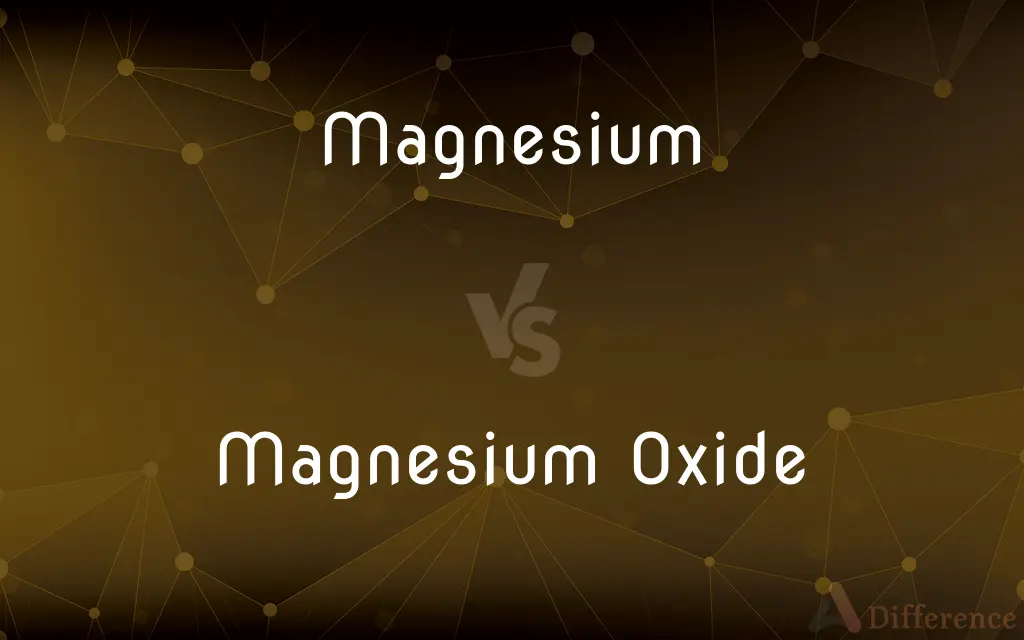Magnesium vs. Magnesium Oxide — What's the Difference?
By Tayyaba Rehman — Published on December 22, 2023
Magnesium is a silver-white metallic element. Magnesium Oxide is a white compound formed when magnesium reacts with oxygen. While both relate to magnesium, one is an element and the other is a compound.

Difference Between Magnesium and Magnesium Oxide
Table of Contents
ADVERTISEMENT
Key Differences
Magnesium and Magnesium Oxide differ fundamentally in their nature and properties. Magnesium is a chemical element with the symbol Mg and is found naturally in various forms. In contrast, Magnesium Oxide, often denoted as MgO, is a chemical compound resulting from the reaction of magnesium with oxygen.
Magnesium, as an elemental metal, is shiny and silvery-white, commonly found in the Earth's crust and used in various industrial applications. On the other hand, Magnesium Oxide appears as a white powder or crystalline solid, utilized extensively in medicine, agriculture, and other sectors.
Reactivity is another distinguishing factor. Magnesium, being a metal, can react with oxygen to form Magnesium Oxide. When this reaction occurs, magnesium loses its metallic characteristics, leading to the creation of a stable oxide compound.
Magnesium plays a crucial role in biological systems, aiding in several cellular functions and enzyme activities. Magnesium Oxide, conversely, serves more external purposes like being an antacid to treat indigestion or as a source of magnesium for plants in agriculture.
In summary, while Magnesium is an essential metallic element with diverse applications, Magnesium Oxide is a derived compound with its set of unique uses, mainly outside the realm of pure metallurgy.
ADVERTISEMENT
Comparison Chart
Appearance
Shiny, silvery-white metal
White powder or crystalline solid
Chemical Formula
Mg
MgO
Reactivity
Can react with oxygen
Stable and doesn't readily react
Primary Uses
Alloys, biological functions
Medicine, agriculture, ceramics
Compare with Definitions
Magnesium
A light, silvery-white metallic element.
Magnesium is essential for many cellular processes in our body.
Magnesium Oxide
A refractory material used in the making of crucibles.
Due to its high melting point, Magnesium Oxide is ideal for certain industrial applications.
Magnesium
A metal that burns with a brilliant white flame.
In a dramatic demonstration, the teacher burned magnesium ribbon in the classroom.
Magnesium Oxide
A compound used as a magnesium supplement in agriculture.
To address magnesium deficiency in plants, gardeners might use Magnesium Oxide.
Magnesium
A chemical element with the symbol Mg.
Magnesium reacts with acids to produce hydrogen gas.
Magnesium Oxide
A white powdery compound formed by the oxidation of magnesium.
Magnesium Oxide is often used as an antacid.
Magnesium
An element crucial for enzyme activity in biological systems.
The doctor advised him to take magnesium supplements for muscle function.
Magnesium Oxide
A chemical compound with the formula MgO.
Farmers sometimes add Magnesium Oxide to soils to counteract acidity.
Magnesium
The eighth most abundant element in the Earth's crust.
Manufacturers often alloy aluminum with magnesium to enhance its strength.
Magnesium Oxide
An ionic compound resulting from magnesium's reaction with oxygen.
When magnesium burns, it forms Magnesium Oxide.
Magnesium
A light, silvery-white, moderately hard metallic element that in ribbon or powder form burns with a brilliant white flame. Obtained chiefly from magnesite, dolomite, and bodies of salt water, it is used in structural alloys, pyrotechnics, flash photography, and incendiary bombs. Atomic number 12; atomic weight 24.305; melting point 650°C; boiling point 1,090°C; specific gravity 1.738 (at 20°C); valence 2. See Periodic Table.
Magnesium
The chemical element (symbol Mg) with an atomic number of 12. It is a light, easily flammable, silvery-white alkaline earth metal.
Magnesium
A light silver-white metallic element of atomic number 12, malleable and ductile, quite permanent in dry air but tarnishing in moist air. It burns, forming (the oxide) magnesia, with the production of a blinding light (the so-called magnesium light) which is used in signaling, in pyrotechny, or in photography where a strong actinic illuminant is required. Its compounds occur abundantly, as in dolomite, talc, meerschaum, etc. Symbol Mg. Atomic weight, 24.305. Specific gravity, 1.75.
Magnesium
A light silver-white ductile bivalent metallic element; in pure form it burns with brilliant white flame; occurs naturally only in combination (as in magnesite and dolomite and carnallite and spinel and olivine)
Common Curiosities
What is Magnesium?
Magnesium is a light, silvery-white metallic element essential in various biological and industrial applications.
Can Magnesium Oxide be reverted back to Magnesium?
Not easily. Reverting Magnesium Oxide to Magnesium requires a reduction process, typically involving high temperatures.
Why is Magnesium crucial biologically?
Magnesium plays a role in numerous cellular functions and is vital for enzyme activity.
How is Magnesium Oxide formed?
Magnesium Oxide forms when magnesium reacts with oxygen, producing a white powdery compound.
Why is Magnesium Oxide considered refractory?
Because of its high melting point and resistance to heat and wear, making it suitable for high-temperature applications.
What is a primary use of Magnesium Oxide in medicine?
Magnesium Oxide is commonly used as an antacid to treat indigestion.
Is Magnesium reactive?
Yes, magnesium can react with various substances, notably with oxygen to form Magnesium Oxide.
What happens when Magnesium burns?
When burned, Magnesium produces a brilliant white flame and forms Magnesium Oxide.
Is Magnesium essential for human health?
Absolutely, magnesium is crucial for many body processes, including muscle and nerve function.
Can Magnesium naturally be found pure in nature?
Rarely. Magnesium typically occurs in compound forms, like in minerals.
How does Magnesium Oxide benefit agriculture?
Magnesium Oxide is a source of magnesium for plants and can neutralize acidic soils.
Is Magnesium Oxide safe for consumption?
In regulated amounts, Magnesium Oxide is used as a dietary supplement and antacid.
Share Your Discovery

Previous Comparison
Act Utilitarianism vs. Rule Utilitarianism
Next Comparison
FPTP vs. PRAuthor Spotlight
Written by
Tayyaba RehmanTayyaba Rehman is a distinguished writer, currently serving as a primary contributor to askdifference.com. As a researcher in semantics and etymology, Tayyaba's passion for the complexity of languages and their distinctions has found a perfect home on the platform. Tayyaba delves into the intricacies of language, distinguishing between commonly confused words and phrases, thereby providing clarity for readers worldwide.













































